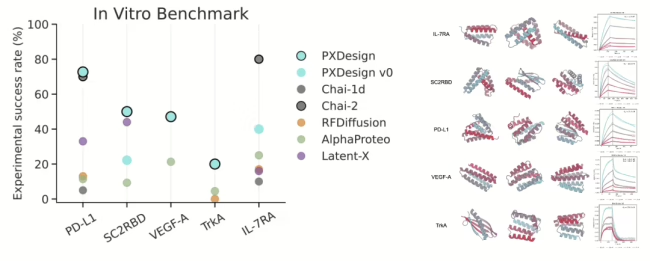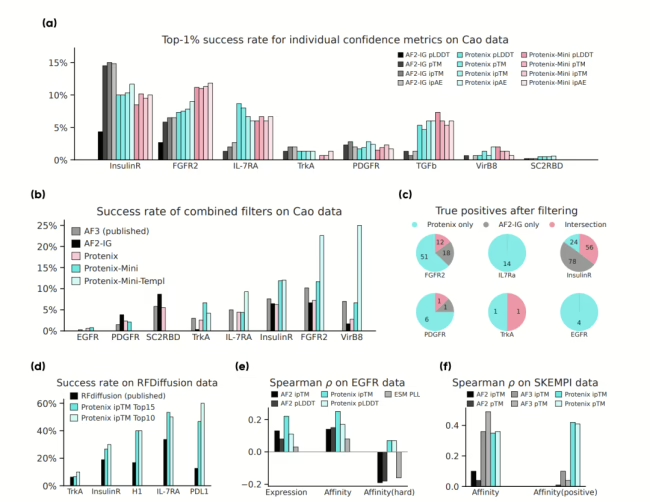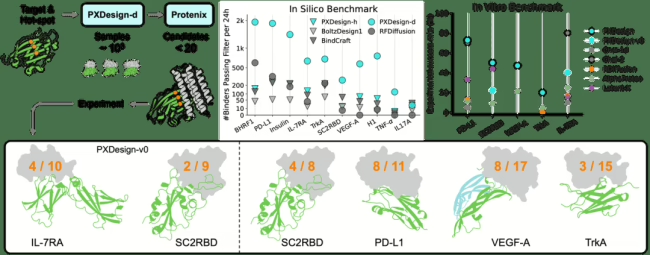The Seed team at ByteDance has announced a major breakthrough in computational biology with the release of PXDesign, a scalable protein design framework developed under its multimodal biomolecular structure foundation model project, Protenix.
In real-world tests, PXDesign demonstrated extraordinary efficiency—generating hundreds of high-quality protein candidates within just 24 hours, representing a 10x improvement over mainstream industry methods. Even more striking, PXDesign achieved 20%–73% wet-lab success rates across multiple targets, setting a new benchmark in the protein design field.
For comparison, DeepMind’s AlphaProteo, based on its AlphaFold series, reported success rates of only 9%–33% on the same targets.
To accelerate adoption, the Protenix team has also launched a free, publicly available binder design service, enabling scientists to harness PXDesign’s capabilities instantly without building complex pipelines.
Why This Matters: From Structure Prediction to Functional Protein Creation
Proteins are the molecular engines of life. The 2024 Nobel Prize in Chemistry highlighted this very frontier—awarding half to David Baker for computational protein design, and half to Demis Hassabis and John Jumper for protein structure prediction (AlphaFold).
The scientific challenge is clear: moving beyond predicting structures to designing brand-new proteins tailored for therapeutic functions. Among these, binders—proteins that precisely latch onto specific targets—are considered especially promising for developing treatments against cancer, infections, and other major diseases.
Historically, protein design required high-throughput experimental screening, often testing tens of thousands of candidates to find just a few viable hits. This approach was costly and inefficient. But recent advances in deep learning have unlocked new opportunities for AI-driven protein engineering—a trend that is rapidly reshaping biotechnology and pharmaceutical research.
Against this backdrop, ByteDance’s PXDesign now delivers one of the highest success rates to date, outperforming AlphaProteo by 2–6x on the same targets. 
The PXDesign Breakthrough: “Generate + Filter” Strategy
The Protenix team attributes their success to a two-step pipeline:
-
Generation (PXDesign-d & PXDesign-h)
-
Two approaches were developed:
-
PXDesign-d (Diffusion-based): excels in generation quality, throughput, and diversity. Particularly effective on challenging targets such as VEGF-A, H1, and TNF-α, achieving efficiency gains of up to hundreds of times compared with prior methods.
-
PXDesign-h (Hallucination-based): leverages AlphaFold-style models as “scorers” for iterative optimization.
-
-
PXDesign-d’s edge comes from its O(N²) DiT architecture, more scalable and efficient than RFdiffusion’s O(N³) modules.
-
-
Filtering (Protenix & Protenix-Mini)
-
After generation, candidates are screened using structure prediction confidence scores.
-
The Protenix model, an open-source AlphaFold 3–level predictor, consistently outperforms AlphaFold 2 in binder selection.
-
Protenix-Mini further accelerates this step by cutting AlphaFold’s 200 diffusion steps down to just 2 steps, enabling faster, large-scale evaluations.
-

This “generate + filter” strategy ensures both speed and accuracy, enabling PXDesign to reach record-high wet-lab success rates.
From Research to Application: PXDesign Server & PXDesignBench
To make protein binder design more accessible, the team has released two key tools:
-
PXDesign Server (pxdesign-server.com)
-
Provides a web-based binder design service with two modes:
-
Preview (20–30 min, returns 5–25 candidates for rapid testing).
-
Extended (generates larger, higher-quality candidate sets with detailed evaluation metrics).
-
-
Significantly reduces design cycles from days to hours, democratizing access to state-of-the-art protein design.
-
-
PXDesignBench (GitHub repo)
-
An open benchmarking suite that standardizes evaluation across datasets, filters, and metrics.
-
Ensures fair comparison of new AI protein design methods, addressing a long-standing challenge in the field.
-
The Bigger Picture: AI Biotech Enters the Industrial Era
ByteDance is not alone.
-
Microsoft recently released BioEmu, an open-source dynamic prediction model.
-
Apple announced SimpleFold, its proprietary protein folding AI.
These moves highlight a broader trend: AI for biology and drug discovery is moving from academia into industry. Just as chips became a battleground for tech giants, protein design may become the next strategic frontier.
🔗 Resources:
-
Project page: https://protenix.github.io/pxdesign/
-
Technical report: PDF
-
PXDesign Server: https://protenix-server.com
-
PXDesignBench: https://github.com/bytedance/PXDesignBench

